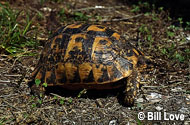Description:
The Greek tortoise actually consists of several forms that occur throughout its wide range. Those that occur north of the Mediterranean Sea are more cold tolerant and usually hibernate when the weather dictates. Those varieties that occur in the Middle East and south of the Mediterranean are less cold tolerant and do not usually hibernate. The southern forms of the Greek tortoise should be kept at a temperature of no less than 80 degrees Fahrenheit with a basking spot of at least 100 degrees. The northern forms will tolerate cooler temperatures but will tend to be inclined to hibernate if temperatures drop too low for too long. The recommended temperature range for the northern forms is 75 to 90 degrees. The dietary requirements are pretty much the same for all form of Greek tortoises regardless of the region they come from in that they will eat dark leafy greens, fibrous fruits such as apples and pears. They will also take berries such as strawberries, blueberries and the like. The fruits and berries should be a small portion of their diet with the dark leafy greens making up the majority of their diet. Although the Greek tortoises are not known grazers they will consume grasses. Water should be provided at all times.
Habitat:
Coastal dunes, grassland, semi-desert and sparsely vegetated scrub land.
Range:
North Africa, Southern Spain, Sardinia, Turkey and the Middle East.
Scientific Name: Testudo graeca
Species Group: tortoise
Family: Testudinidae
Size: 2 to 5 lbs
Level: intermediate
Weight: N/A
Dangerous: No


